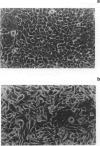Abstract
Although EGF receptor expression is generally elevated in human lung squamous carcinoma, the biological significance of this phenomenon and the role of EGF and TGF-alpha in this disease are poorly understood. We have investigated three human lung squamous carcinoma cell lines (NX002, CX140 and CX143) and have shown, using an antibody (EGFR1) directed against the EGF receptor, that the majority of cells in all three lines express the EGF receptor. Using a ligand binding assay, Scatchard analysis indicated high concentrations (1,300-2,700 fmol mg-1 protein) of a single low affinity binding site (Kd = 3-5 nM) within these lines. Addition of EGF or TGF-alpha at concentrations greater than 0.1 nM resulted in growth inhibition of all three lines and this was associated with an accumulation of cells in the G2/M phase of the cell cycle. Growth inhibitory effects were not explained by an enhancement of cellular differentiation as monitored by involucrin expression and the ability to form cornified envelopes. While the presence of EGF could not be detected in medium conditioned by the NX002 cell line, mRNA for TGF-alpha was detected in all three lines suggesting the possibility of an autocrine loop. These results together with reports of growth inhibition by EGF and TGF-alpha in other systems suggest that EGF and similar molecules might have a growth regulatory role in lung cancer cells and modulation of such may have therapeutic potential.
Full text
PDF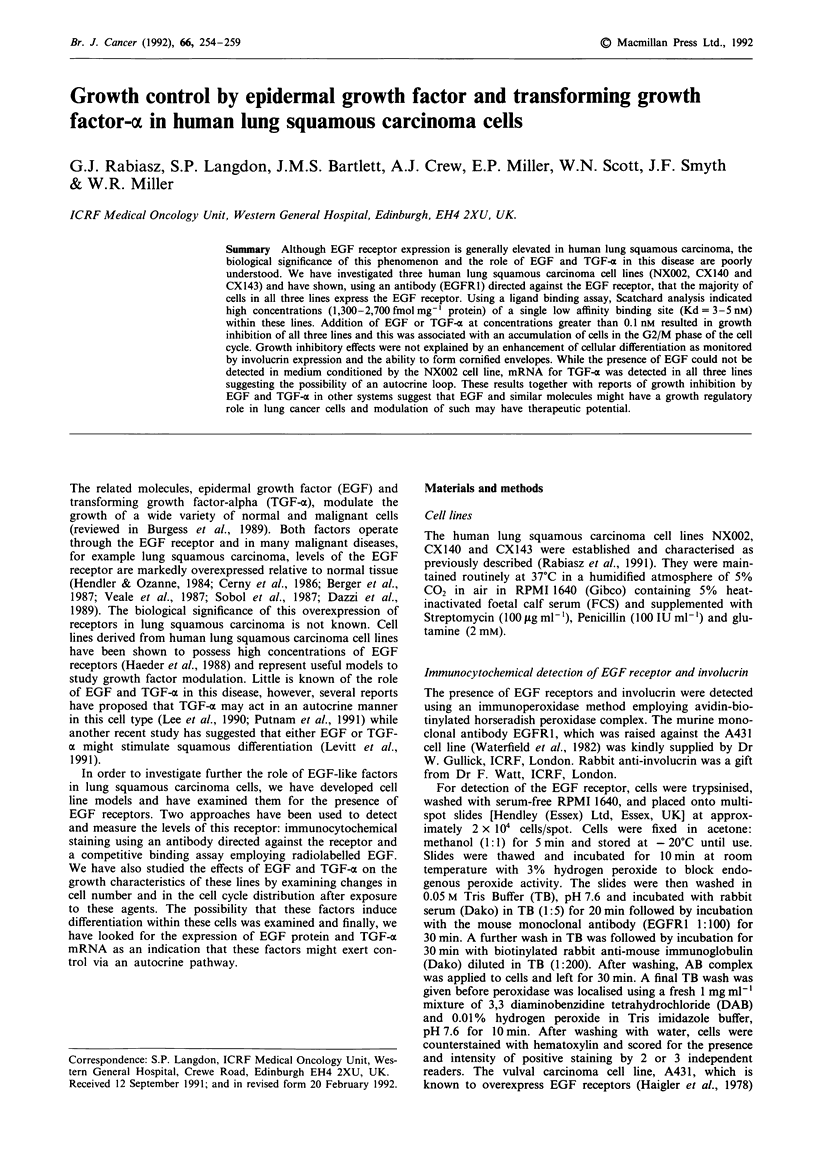
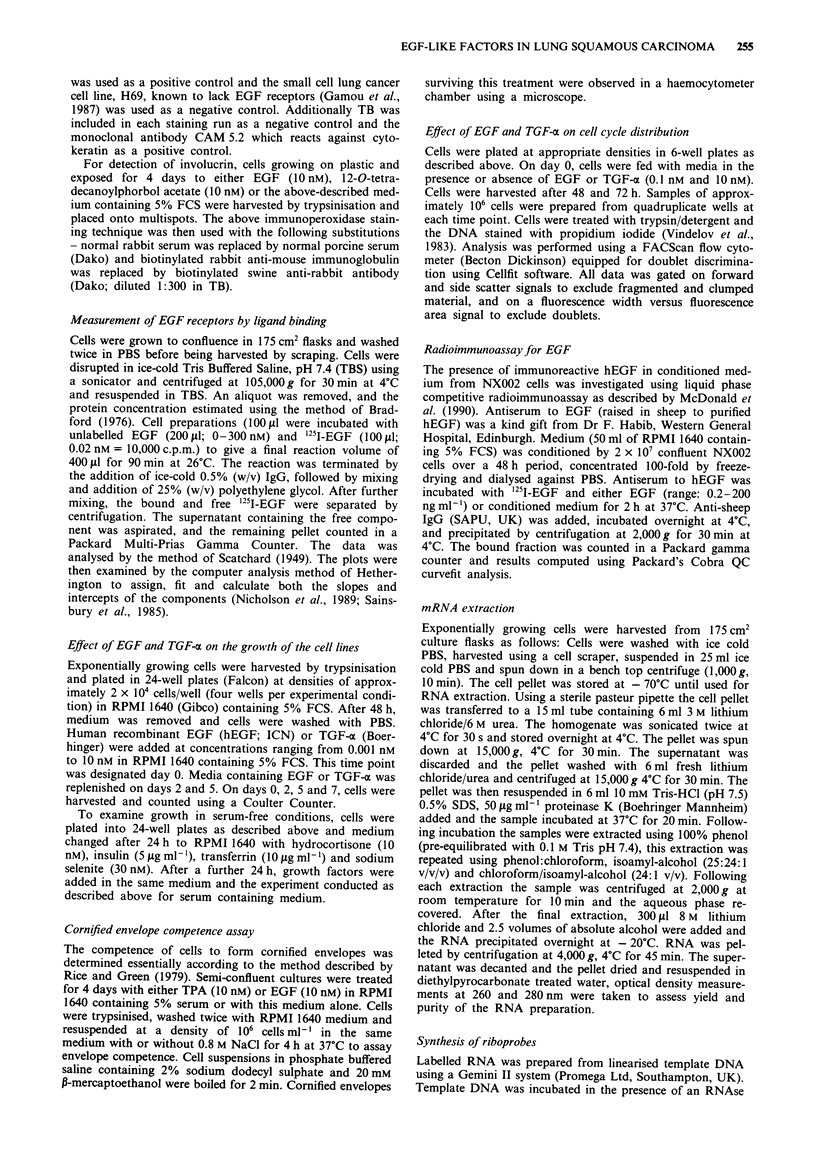
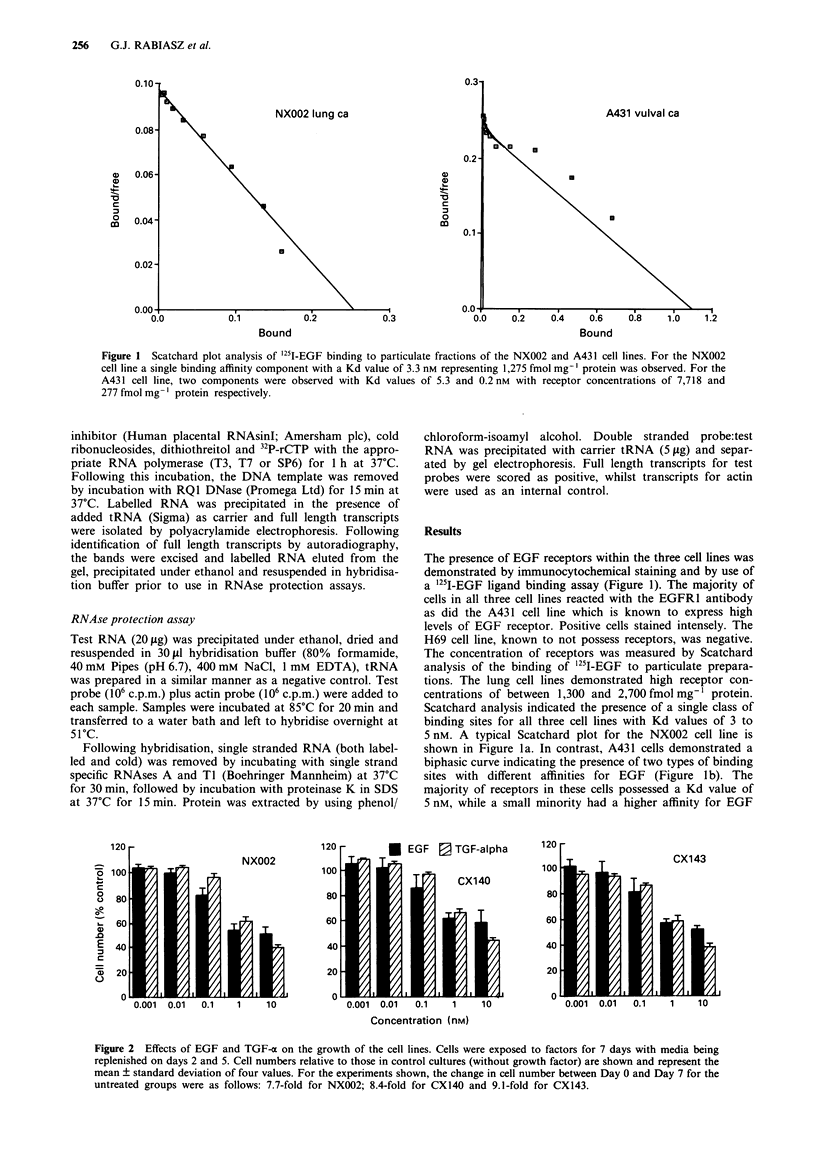
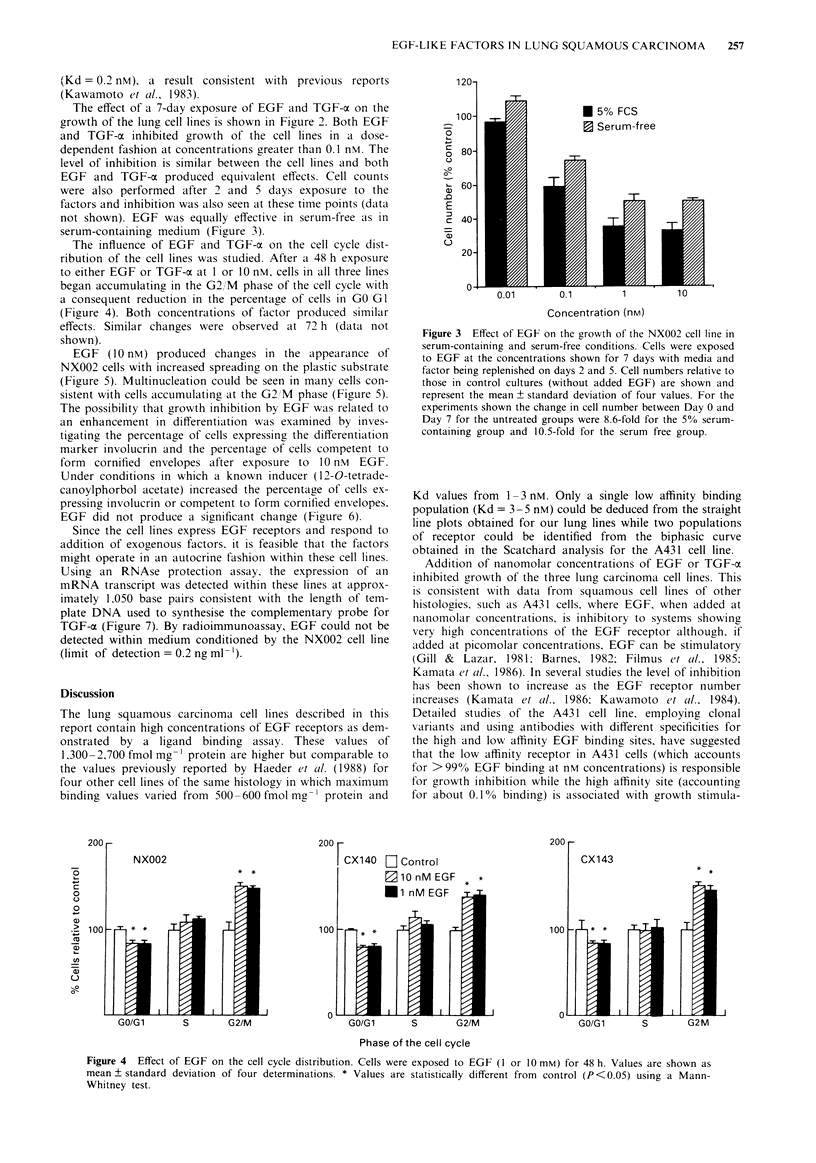
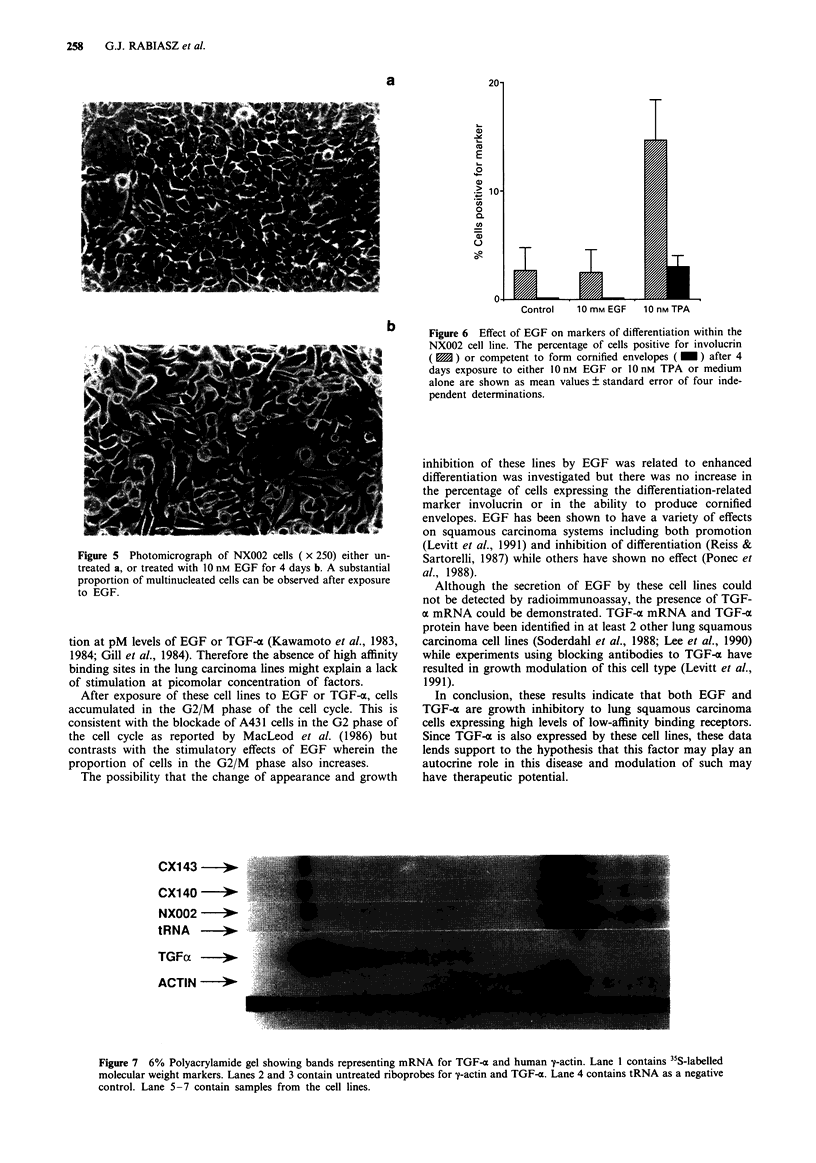
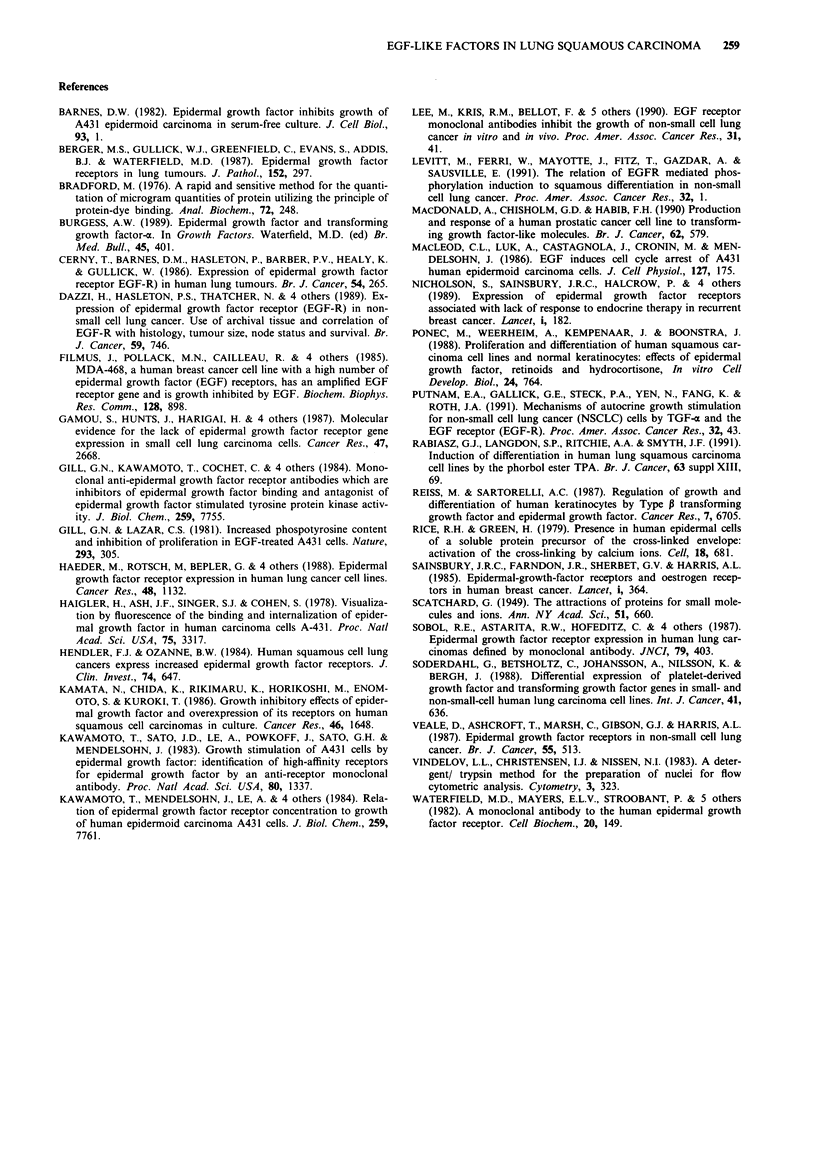
Images in this article
Selected References
These references are in PubMed. This may not be the complete list of references from this article.
- Barnes D. W. Epidermal growth factor inhibits growth of A431 human epidermoid carcinoma in serum-free cell culture. J Cell Biol. 1982 Apr;93(1):1–4. doi: 10.1083/jcb.93.1.1. [DOI] [PMC free article] [PubMed] [Google Scholar]
- Berger M. S., Gullick W. J., Greenfield C., Evans S., Addis B. J., Waterfield M. D. Epidermal growth factor receptors in lung tumours. J Pathol. 1987 Aug;152(4):297–307. doi: 10.1002/path.1711520408. [DOI] [PubMed] [Google Scholar]
- Bradford M. M. A rapid and sensitive method for the quantitation of microgram quantities of protein utilizing the principle of protein-dye binding. Anal Biochem. 1976 May 7;72:248–254. doi: 10.1016/0003-2697(76)90527-3. [DOI] [PubMed] [Google Scholar]
- Cerny T., Barnes D. M., Hasleton P., Barber P. V., Healy K., Gullick W., Thatcher N. Expression of epidermal growth factor receptor (EGF-R) in human lung tumours. Br J Cancer. 1986 Aug;54(2):265–269. doi: 10.1038/bjc.1986.172. [DOI] [PMC free article] [PubMed] [Google Scholar]
- Dazzi H., Hasleton P. S., Thatcher N., Barnes D. M., Wilkes S., Swindell R., Lawson R. A. Expression of epidermal growth factor receptor (EGF-R) in non-small cell lung cancer. Use of archival tissue and correlation of EGF-R with histology, tumour size, node status and survival. Br J Cancer. 1989 May;59(5):746–749. doi: 10.1038/bjc.1989.156. [DOI] [PMC free article] [PubMed] [Google Scholar]
- Filmus J., Pollak M. N., Cailleau R., Buick R. N. MDA-468, a human breast cancer cell line with a high number of epidermal growth factor (EGF) receptors, has an amplified EGF receptor gene and is growth inhibited by EGF. Biochem Biophys Res Commun. 1985 Apr 30;128(2):898–905. doi: 10.1016/0006-291x(85)90131-7. [DOI] [PubMed] [Google Scholar]
- Gamou S., Hunts J., Harigai H., Hirohashi S., Shimosato Y., Pastan I., Shimizu N. Molecular evidence for the lack of epidermal growth factor receptor gene expression in small cell lung carcinoma cells. Cancer Res. 1987 May 15;47(10):2668–2673. [PubMed] [Google Scholar]
- Gill G. N., Kawamoto T., Cochet C., Le A., Sato J. D., Masui H., McLeod C., Mendelsohn J. Monoclonal anti-epidermal growth factor receptor antibodies which are inhibitors of epidermal growth factor binding and antagonists of epidermal growth factor binding and antagonists of epidermal growth factor-stimulated tyrosine protein kinase activity. J Biol Chem. 1984 Jun 25;259(12):7755–7760. [PubMed] [Google Scholar]
- Gill G. N., Lazar C. S. Increased phosphotyrosine content and inhibition of proliferation in EGF-treated A431 cells. Nature. 1981 Sep 24;293(5830):305–307. doi: 10.1038/293305a0. [DOI] [PubMed] [Google Scholar]
- Haeder M., Rotsch M., Bepler G., Hennig C., Havemann K., Heimann B., Moelling K. Epidermal growth factor receptor expression in human lung cancer cell lines. Cancer Res. 1988 Mar 1;48(5):1132–1136. [PubMed] [Google Scholar]
- Haigler H., Ash J. F., Singer S. J., Cohen S. Visualization by fluorescence of the binding and internalization of epidermal growth factor in human carcinoma cells A-431. Proc Natl Acad Sci U S A. 1978 Jul;75(7):3317–3321. doi: 10.1073/pnas.75.7.3317. [DOI] [PMC free article] [PubMed] [Google Scholar]
- Hendler F. J., Ozanne B. W. Human squamous cell lung cancers express increased epidermal growth factor receptors. J Clin Invest. 1984 Aug;74(2):647–651. doi: 10.1172/JCI111463. [DOI] [PMC free article] [PubMed] [Google Scholar]
- Kamata N., Chida K., Rikimaru K., Horikoshi M., Enomoto S., Kuroki T. Growth-inhibitory effects of epidermal growth factor and overexpression of its receptors on human squamous cell carcinomas in culture. Cancer Res. 1986 Apr;46(4 Pt 1):1648–1653. [PubMed] [Google Scholar]
- Kawamoto T., Mendelsohn J., Le A., Sato G. H., Lazar C. S., Gill G. N. Relation of epidermal growth factor receptor concentration to growth of human epidermoid carcinoma A431 cells. J Biol Chem. 1984 Jun 25;259(12):7761–7766. [PubMed] [Google Scholar]
- Kawamoto T., Sato J. D., Le A., Polikoff J., Sato G. H., Mendelsohn J. Growth stimulation of A431 cells by epidermal growth factor: identification of high-affinity receptors for epidermal growth factor by an anti-receptor monoclonal antibody. Proc Natl Acad Sci U S A. 1983 Mar;80(5):1337–1341. doi: 10.1073/pnas.80.5.1337. [DOI] [PMC free article] [PubMed] [Google Scholar]
- MacDonald A., Chisholm G. D., Habib F. K. Production and response of a human prostatic cancer line to transforming growth factor-like molecules. Br J Cancer. 1990 Oct;62(4):579–584. doi: 10.1038/bjc.1990.333. [DOI] [PMC free article] [PubMed] [Google Scholar]
- MacLeod C. L., Luk A., Castagnola J., Cronin M., Mendelsohn J. EGF induces cell cycle arrest of A431 human epidermoid carcinoma cells. J Cell Physiol. 1986 Apr;127(1):175–182. doi: 10.1002/jcp.1041270121. [DOI] [PubMed] [Google Scholar]
- Nicholson S., Sainsbury J. R., Halcrow P., Chambers P., Farndon J. R., Harris A. L. Expression of epidermal growth factor receptors associated with lack of response to endocrine therapy in recurrent breast cancer. Lancet. 1989 Jan 28;1(8631):182–185. doi: 10.1016/s0140-6736(89)91202-6. [DOI] [PubMed] [Google Scholar]
- Ponec M., Weerheim A., Kempenaar J., Boonstra J. Proliferation and differentiation of human squamous carcinoma cell lines and normal keratinocytes: effects of epidermal growth factor, retinoids, and hydrocortisone. In Vitro Cell Dev Biol. 1988 Aug;24(8):764–770. doi: 10.1007/BF02623646. [DOI] [PubMed] [Google Scholar]
- Reiss M., Sartorelli A. C. Regulation of growth and differentiation of human keratinocytes by type beta transforming growth factor and epidermal growth factor. Cancer Res. 1987 Dec 15;47(24 Pt 1):6705–6709. [PubMed] [Google Scholar]
- Rice R. H., Green H. Presence in human epidermal cells of a soluble protein precursor of the cross-linked envelope: activation of the cross-linking by calcium ions. Cell. 1979 Nov;18(3):681–694. doi: 10.1016/0092-8674(79)90123-5. [DOI] [PubMed] [Google Scholar]
- Sainsbury J. R., Farndon J. R., Sherbet G. V., Harris A. L. Epidermal-growth-factor receptors and oestrogen receptors in human breast cancer. Lancet. 1985 Feb 16;1(8425):364–366. doi: 10.1016/s0140-6736(85)91385-6. [DOI] [PubMed] [Google Scholar]
- Sobol R. E., Astarita R. W., Hofeditz C., Masui H., Fairshter R., Royston I., Mendelsohn J. Epidermal growth factor receptor expression in human lung carcinomas defined by a monoclonal antibody. J Natl Cancer Inst. 1987 Sep;79(3):403–407. [PubMed] [Google Scholar]
- Söderdahl G., Betsholtz C., Johansson A., Nilsson K., Bergh J. Differential expression of platelet-derived growth factor and transforming growth factor genes in small- and non-small-cell human lung carcinoma lines. Int J Cancer. 1988 Apr 15;41(4):636–641. doi: 10.1002/ijc.2910410426. [DOI] [PubMed] [Google Scholar]
- Veale D., Ashcroft T., Marsh C., Gibson G. J., Harris A. L. Epidermal growth factor receptors in non-small cell lung cancer. Br J Cancer. 1987 May;55(5):513–516. doi: 10.1038/bjc.1987.104. [DOI] [PMC free article] [PubMed] [Google Scholar]
- Vindeløv L. L., Christensen I. J., Nissen N. I. A detergent-trypsin method for the preparation of nuclei for flow cytometric DNA analysis. Cytometry. 1983 Mar;3(5):323–327. doi: 10.1002/cyto.990030503. [DOI] [PubMed] [Google Scholar]
- Waterfield M. D., Mayes E. L., Stroobant P., Bennet P. L., Young S., Goodfellow P. N., Banting G. S., Ozanne B. A monoclonal antibody to the human epidermal growth factor receptor. J Cell Biochem. 1982;20(2):149–161. doi: 10.1002/jcb.240200207. [DOI] [PubMed] [Google Scholar]



